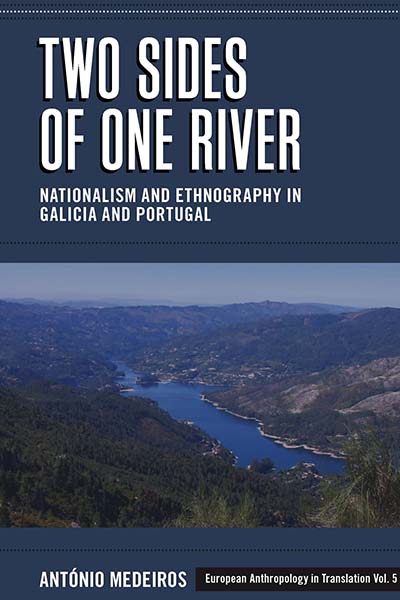 Berghahn has just released Two Sides of One River: Nationalism and Ethnography in Galicia and Portugal, an English translation by Martin Earl of the original Portuguese volume by António Medeiros. This book explores the historical intersections between nationalism and the emergence of ethnographic traditions in Portugal and Galicia, and plays this history against the author’s own ethnographic research in both places at the turn of the 20th century.
Berghahn has just released Two Sides of One River: Nationalism and Ethnography in Galicia and Portugal, an English translation by Martin Earl of the original Portuguese volume by António Medeiros. This book explores the historical intersections between nationalism and the emergence of ethnographic traditions in Portugal and Galicia, and plays this history against the author’s own ethnographic research in both places at the turn of the 20th century.
Category: In Their Own Words
Comics and Contradictions with Laurence Grove, co-editor of European Comic Art
Note: Berghahn recently released the paperback edition of Laurence Grove’s Comics in French and also publishes the journal European Comic Art, which he co-edits. Here he discusses his current work on an exhibit of comics for the Hunterian Art Gallery in Glasgow.
__________________________________________
One of the inspiring things about co-editing European Comic Art, apart from the buzz of working with Ann Miller and Mark McKinney, is the connections it creates. In recent times we have had the pleasure of receiving scholarship on comic art from England, France, Greece, Canada, Italy, Spain, Argentina and Germany, and from the eighteenth century to the twenty-first. It is not long before you are reminded that whatever your speciality, there are unexpected link-ins elsewhere and contradictions to the knowledge we might have taken for granted.
It may seem strange, therefore, that one of my current projects is to prepare an exhibition whose provisional title, Scotland and the Birth of Comics, could appear to bask in positivist certainties. The display, which will open in Glasgow’s Hunterian Art Gallery before touring, will bring to light a little-known work of primary importance, The Glasgow Looking Glass of 1825. The Looking Glass appears to be the world’s oldest comic, predating the earliest published ‘comics’ by Rodolphe Töpffer by eight years, Le Charivari by seven, and Punch by sixteen. Building on the historic angle and taking the notion of graphic narrative in its widest sense, the exhibition will allow us to showcase Hunterian treasures from the Roman period to Hogarth and on to contemporary selections, as well as key manuscripts and printed works from Glasgow University Library’s Special Collections and certain related items from Glasgow’s museums.

With the permission of Special Collections, University of Glasgow Library. (Sp Coll Bh14-x.8)
At the initial research stage (I have the Glasgow Looking Glass in front of me as I write) I have been struck by the intertwining connections. The Looking Glass inspired Punch, but its characters—the street musicians, the clergymen, the medics, and so on—also offer firm reminders of the styles of Töpffer, Rowlandson, and Hogarth. It is thus inevitable that the exhibition will lure the visitor in with the promise of newly-found canonical certainties (comics started in a specific time and place, and that is Glasgow in 1825), only then to make it clear that the complexities are so that such certainties must be flawed.

With the permission of Special Collections, University of Glasgow Library (Sp Coll Bh14-x.8)
This week I am going to Geneva to meet with the Director of the Bibliothèque de Genève, Alexandre Vanautgaerden, and his team, with a view to a possible loan of a Töpffer manuscript. Ironically, having made the notion that Töpffer did not invent the comic strip (nor did anyone else) a central theme of my Comics in French (Berghahn Books), I am strangely excited about getting to see the Swiss schoolteacher’s creations in the flesh. It is the fact that life is a hybrid art full of contradictions that makes it such fun. A bit like comics.
__________________________________________
Laurence Grove is is Reader in French and Director of the Stirling Maxwell Centre for the Study of Text/Image Cultures at the University of Glasgow.
To view more images from the collection, visit the Glasgow University Library Special Collections Department.
An Excerpt from Tuff City: Urban Change and Contested Space in Central Naples
Tuff City is an ethnographic history of urban renewal in the historic centre of Naples during the 1990s under the stewardship of the city’s first directly elected mayor, former communist Antonio Bassolino. Through the study of two major piazzas and a squatted centro sociale (social centre), the book explores the pivotal role of public space in the administration’s efforts to reorder and redefine a city that had hitherto been commonly regarded as an urban outcast. It thus sets out to investigate how changes to the built environment were, on the one hand, produced and publicly endorsed and, on the other, experienced and contested by different groups of people. Understanding public space means grappling with the messy and perhaps ugly pluralism that constitutes urban life, rather than unwittingly confirming normative and institutional ideals about a ‘good’ (and, especially in the case of Naples, ‘well-behaved’) city.
the 1990s under the stewardship of the city’s first directly elected mayor, former communist Antonio Bassolino. Through the study of two major piazzas and a squatted centro sociale (social centre), the book explores the pivotal role of public space in the administration’s efforts to reorder and redefine a city that had hitherto been commonly regarded as an urban outcast. It thus sets out to investigate how changes to the built environment were, on the one hand, produced and publicly endorsed and, on the other, experienced and contested by different groups of people. Understanding public space means grappling with the messy and perhaps ugly pluralism that constitutes urban life, rather than unwittingly confirming normative and institutional ideals about a ‘good’ (and, especially in the case of Naples, ‘well-behaved’) city.
The following extract is taken from the case study of DAMM located in the popular quarter of Montesanto. As a local resident, I grew to appreciate the complex dynamics of the surrounding social milieu that some outside observers have hastily (mis)labelled ‘inner city’ or ‘working class’ and which local orthodox leftists had in the past dismissed as ‘lumpen’ and ‘pre-political’. Following the occupation of a three-storey building in 1995, the occupants of DAMM – a mix of local residents, students and cultural workers – sought to develop an alternative idea of public space through the self-management of an adjacent park and public escalator system that were built following the 1980 earthquake, but which had been left in a state of abandonment. This extract highlights a theme that lies at the heart of Tuff City, namely, how the politics of regeneration was continually stymied and reformulated through everyday uses of, and struggles over urban space. Continue reading “An Excerpt from Tuff City: Urban Change and Contested Space in Central Naples ”
The fantasy of a historical source
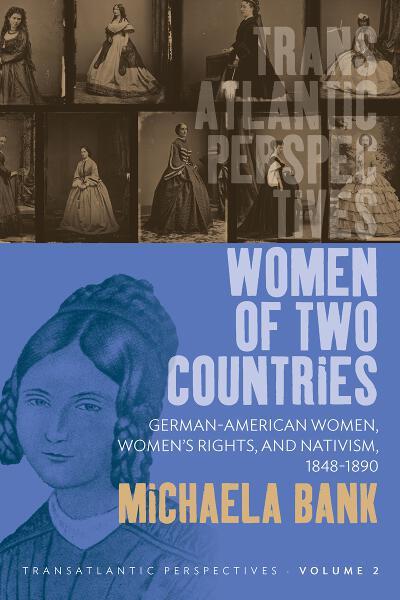 Michaela Bank’s Women of Two Countries: German-American Women, Women’s Rights and Nativism, 1848-1890 has just been released by Berghahn. The second volume in our new series Transatlantic Perspectives, it focuses on the challenges faced by three German-American feminists not only with the US women’s rights movement itself but also within their own ethnic community. In the following post, the author recounts the discovery of a seemingly significant event while undertaking her research.
Michaela Bank’s Women of Two Countries: German-American Women, Women’s Rights and Nativism, 1848-1890 has just been released by Berghahn. The second volume in our new series Transatlantic Perspectives, it focuses on the challenges faced by three German-American feminists not only with the US women’s rights movement itself but also within their own ethnic community. In the following post, the author recounts the discovery of a seemingly significant event while undertaking her research.
_______________________________
When I first spent long days in libraries and archives to find out more about German-American women’s participation in the US women’s rights movement I stumbled over an extensive report of a German women’s rights convention that took place in 1868 near Boston. Reading the report, which had been published in a German-language paper by Karl Heinzen, who was one of the rather more radical political editors of the time, I found the presented ideas clear and expressed in sharp language. To give an example, here is what one female speaker is recorded as having said to the audience:
“I predict that, if women are granted the right to vote, the political party that seeks to limit the freedom of social life by moral police and seeks to expand the authority of the clerics by religious coercion will be significantly strengthened. What it has not achieved so far, it will conceivably achieve now with the help of American women who are generally more dependent on the representatives of religion than American men. This party’s goal will be achieved if those women’s additional votes are not made powerless by a pull in the opposite direction. And who shall and will provide this pull? Only the German women!”
Such an openly aggressive opposition to the US-American women’s rights movement among German-American women struck me as rather exceptional. I was thrilled as this convention report was a marvelous source for my study on German-American women, nativism and women’s rights in this period, and so I continued to dig deeper into the sources to find out more about it. How did the grand ladies of the US-American movement, Elizabeth Cady Stanton, Lucy Stone and other prominent advocates of women’s rights, react to this opposition?
…Yet, not all paths in historical research lead to success: I could not find any records of the Roxbury convention anywhere. Then, a few weeks later, I found a short note revealing that Karl Heinzen’s report had actually been a fictional one. Suddenly the shockingly clear and sharp language made sense to me.
Although a fantasy, it remained a fascinating report for me because it illustrated pointedly what a group of German-Americans interested in reform politics thought of the women’s rights movement and why conflict arose so often between the two groups. As I discovered, only a few German-American women were willing to stand up and raise their voice strongly and even aggressively. Such were the women who could endure the tension between their ethnic community, which was often at odds with the US-American women’s rights movement because of its nativist and prohibition stances, and the women’s rights movement that they wanted to be a part of. The efforts of Clara Neymann, Mathilde Wendt, and Mathilde Franziska Anneke for an idea of equal women’s rights are special – special, because they were not at all common while still being powerful and influential. In the end, I was still more than happy that I had found the report of the fictional convention even if it was just a „Hirngespinst“ – a pipe-dream – as a newspaper article called it.
_______________________________
An Excerpt from A Lover’s Quarrel with the Past: Romance, Representation, Reading
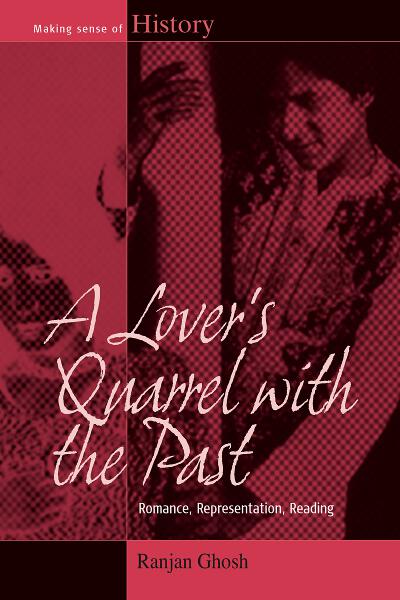 Note: Berghahn recently published Ranjan Ghosh’s A Lover’s Quarrel with the Past: Romance, Representation, Reading, an exploration of the relationship between history and theory. Here the author talks about the origins for the section on dust that appears in the book.
Note: Berghahn recently published Ranjan Ghosh’s A Lover’s Quarrel with the Past: Romance, Representation, Reading, an exploration of the relationship between history and theory. Here the author talks about the origins for the section on dust that appears in the book.
__________________________________
Dust
I suffer from a dust allergy. If I’m really careful, it wouldn’t affect my life in any significant way. For what, after all, are allergies? A few crustaceans managing to live out their lifespan because a gourmet friend of mine suffers from a seafood allergy. Compared to that exchequer, my allergy has almost no exchange value. I can joke about it, although, only in the way a bald stand-up comedian can joke about his hair or lack thereof. For the truth is this: my relationship with dust has affected the way I have done history.
My mother, whose mythical bedtime stories first introduced me to history as a child, was a historian. Her specialisation was numismatics but she eventually gave up teaching history to take over curatorship of the university museum. She was also diagnosed with asthma — a disease for which dust is an enemy — and she suffered especially during the dusty Indian winter months. I subsequently grew up with a psychosomatic hatred for dust: a maid cleaned our house twice a day and I became the subject of much teenage laughter in school, holding, as I did, a hankie to my nose at all times.
Now, why do I say all this? My book, A Lover’s Quarrel with the Past: Romance, Representation, Reading, has a section on dust. When I first read Carolyn Steedman’s fine book, Dust: The Archive and Cultural History (it was published exactly a year after my mother’s death), I was overcome by several strong emotions. Primary among them was a sense of despair. Like my mother who would wheeze at the mention of a furry animal or sandstorm, I read Steedman’s book literally out of breath. My sense of despair came from the realisation that I would never be able to work in an archive — that I would never have a career in dust.
My Lover’s Quarrel is, in that sense, also a quarrel with dust, my private trope for history, the past and the future, beyond the biblical from where we come to where we go.
There is a living, buoyant ligature between a historian and the archival milieux where one encounters the recorded past as much as a ‘history of loss’, where the dust rests as no mere squalid accretions but animated particles that can waft into the historian with differential vibrations….Dust speaks; dust makes us aware of a past that is absent and present at the same time, a temptation to the historian’s reconstructionist desires and a reminder of his or her affiliation to grounded evidence. In a kind of sensory encounter with the past, dust, as a materiality, awaits mediation, conjuring up the ‘presence’ of the past. (102)
My book combines South Asian history with the continental philosophies of history. But my accusative finger is at dust and my physiological condition, which has prevented me from being a ‘proper’ historian. I’ve written on textbooks and pamphlets, and their unique semantics of a propagandist historicising, but I’ve always had to take the help of someone, a kind acquaintance at the library, often my wife or father, to first wipe the dust away from their pages before I could examine them.
That has also become my shorthand for doing history: wiping the dust. In that there is much romance and representation, and of course, always, always, a new reading.
__________________________________
An Excerpt from Patients and Agents: Mental Illness, Modernity and Islam in Sylhet, Bangladesh
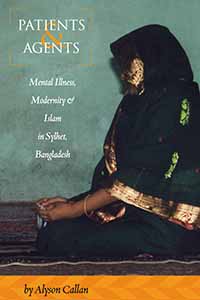 Note: Berghahn has just published Alyson Callan’s Patients and Agents: Mental Illness, Modernity and Islam in Sylhet, Bangladesh, an ethnographic study that explores how changes in the global economy have led to an increase in daughters marrying outside of their local kinship network, which in turn has increased their vulnerability to mental illness. An excerpt with images from Chapter 6 follows an introductory note from the author.
Note: Berghahn has just published Alyson Callan’s Patients and Agents: Mental Illness, Modernity and Islam in Sylhet, Bangladesh, an ethnographic study that explores how changes in the global economy have led to an increase in daughters marrying outside of their local kinship network, which in turn has increased their vulnerability to mental illness. An excerpt with images from Chapter 6 follows an introductory note from the author.
__________________________________________
Bangladesh is one of only five countries in the world where women have a shorter life expectancy than men. The low status of women in Bangladesh is underpinned by the virilocal rule of residence. As daughters leave their natal home to live with their husband’s family at the time of marriage, it is argued that nurturing them is regarded as a relative waste of resources, compared to nurturing sons who will stay and contribute to the wealth of the household.
However, women’s oppression is not experienced in a uniform way. Older women achieve a higher status as mothers, and, as mother-in-laws, may oppress their sons’ wives. The concept ‘woman’ does not occupy a single analytical category and the status of women varies according to the role they occupy. In this excerpt I suggest that the ‘Ma’ icons seen in most rural households provides evidence that the mother is revered on a par with Allah.
The mother in symbolic opposition to Allah
[There is] a tension evident in Bengali culture between the law of the father and the law of the mother. The popular Indian conception of the mother as self-sacrificing overlies an unconscious fantasy of the phallic, castrating mother (Nandy 1990). Bagchi (1990) suggests that Bengali culture is particularly prone to employing this threatening aspect of the mother. The powerful and murderous Kali, who dances on the corpse of her consort Shiva, is a goddess who enjoys greatest popularity amongst Bengalis (Fuller 1992). Wilce (1998a) argues that in Bangladesh mothers are feared and placed in symbolic opposition to Allah. He cites this famous passage from the Hadith: in answer to the question, ‘To whom do I owe the most respect?’ the Prophet replied, ‘Your mother.’ His answer remained the same when pressed to declare the second and third persons deserving respect. ‘Father’ was listed fourth [1998: 108].
Another quotation commonly recited in Sylhet is ‘Heaven is under the mother’s feet’, meaning that obedience to the mother is the path to heaven. Yet whilst the mother-in-law in Sylhet is feared, conscious representations of the mother portray her to be loving and all-forgiving, if not to say indulgent. This latter attribute seems to me to be diametrically opposed to Allah who takes a meticulous account of his subjects’ good and bad works, doling out punishment and rewards as appropriate on Judgement Day. That the mother is revered on a par with Allah is demonstrated by the prevalence of ‘Ma’ iconography (ma is short for amma – mother). (Muslim) lorry drivers have ‘Ma’ painted on the front of their trucks; posters are sold reproducing poems and pictures celebrating the mother. Most strikingly of all, ‘Ma’ embroidery samplers and other ‘Ma’ icons are hung up on the wall next to Islamic icons – Allah’s name in Arabic, Qur’anic verse, pictures of Mecca. I saw these ‘Ma’ icons in every rural household that had grown-up children present; it was explained that ‘we have maya (love) for Allah and amma above everything else; for amma because she has suffered greatly for us’.

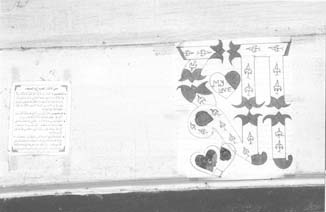
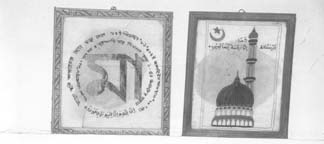
Alyson Callan is a psychiatrist and anthropologist. She currently works as a consultant psychiatrist in Brent for the Central and North West London NHS Foundation Trust.
In their own words: The broader context of Small Town and Village in Bavaria
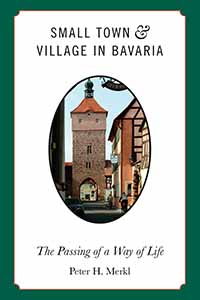 Note: Berghahn recently published Peter H. Merkl’s Small Town and Village in Bavaria: The Passing of a Way of Life, a study of that region’s modernization efforts in the 1970s and 1980s that led to a considerable reduction in the autonomy of its small communities. Here the author discusses how the decline of iconic village life (and the broader implications) motivated his study:
Note: Berghahn recently published Peter H. Merkl’s Small Town and Village in Bavaria: The Passing of a Way of Life, a study of that region’s modernization efforts in the 1970s and 1980s that led to a considerable reduction in the autonomy of its small communities. Here the author discusses how the decline of iconic village life (and the broader implications) motivated his study:
Immense changes have occurred in German agriculture and in the economic and social life of very small towns, which I explore in my work Small Town and Village in Bavaria: The Passing of a Way of Life. In many ways, these changes mirror transformations occurring in small towns across the industrialized world. While many people in today’s urbanized society actually come from small town backgrounds or grew up in the countryside and feel nostalgia for the closeness of small communities or for a family farming way of life, these settings have nearly vanished in the last 100 years or so. Where once a majority of the German population were farmers, only a tiny percentage remain so today and most of them are part-time farmers. The majority of really small places have lost their taverns and other local businesses while both schoolchildren and adults commute daily to distant, larger towns.
While the populations of small places decline, the charms of their old historical structures endure, highlighted in art and literature. When we travel through very old towns we are struck by the medieval walls, gates and turrets, and ancient churches that manifest the venerable age of communities that have witnessed centuries of political and social change. Tourists have discovered such places all over Europe, especially in the United Kingdom, France, and Germany where such well-known medieval towns as Rothenburg on the Tauber River or the small villages along the Romantic Road in Bavaria still enchant the visitor.
My book not only focuses on the long-term changes in German agriculture and in fifteen old Franconian mini-towns but also examines the effects of an ambitious modernization project by the Bavarian state that sought to deprive all communities under a certain size of their autonomy and to force them into “administrative unions” with other small places. It was a process not unfamiliar in the U.S. and many European countries, though usually in a more voluntary form, but resulting in far fewer, modernized local units in either case.
The tension between the preservation of these small communities amid the slow dynamics of social change on the one hand and the massive state intervention to modernize Bavarian local government at the periphery on the other is what drew me to this project. It seemed preposterous to force groups of medieval, independent small towns to merge for the sake of modernization. Through my research, which included several mail surveys of mayors, interviews with state and local officials, and statistical materials, I have created a fuller picture of these micro-towns and placed them within the larger hierarchy of German and European levels of government, providing a clearer context for the changes in these localities.
Peter H. Merkl is Professor Emeritus of Political Science at the University of California, Santa Barbara. He has published extensively on comparative and German government and politics, in particular the origin of the West German Republic and German unification.
An Excerpt from Fortune and the Cursed: The Sliding Scale of Time in Mongolian Divination
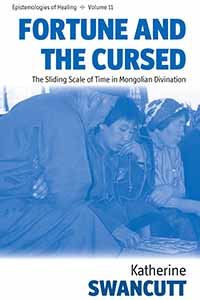 Note: Berghahn recently published Katherine Swancutt’s Fortune and the Cursed: The Sliding Scale of Time in Mongolian Divination, an ethnographic study of the world of Buryat Mongol divination. An excerpt from the book follows a note from the author which places it in the context of her larger argument.
Note: Berghahn recently published Katherine Swancutt’s Fortune and the Cursed: The Sliding Scale of Time in Mongolian Divination, an ethnographic study of the world of Buryat Mongol divination. An excerpt from the book follows a note from the author which places it in the context of her larger argument.
It’s common knowledge that, when under duress, many people turn to religion. Yet the human penchant for inventing new magical practices during this ‘turn to religion’ is rarely revealed.
When I first went to Mongolia, I wanted to uncover how a shamanic cosmology comes to be reinvented over time. My plan was to document the shamanic practices – and especially the divinations (aka ‘fortune-tellings’) – undertaken by Buryat Mongols at the northeastern fringes of the country. These shamans manage everything from major health and business crises to everyday fluctuations in a person’s fortune, which, I learned, is not just a kind of luck-filled prosperity that can rise or fall dramatically. Fortune is also a driving force behind Buryat innovation-making. Continue reading “An Excerpt from Fortune and the Cursed: The Sliding Scale of Time in Mongolian Divination”
